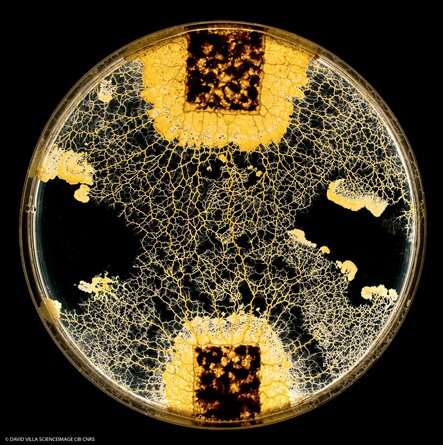Slime mold absorbs substances to memorize them

In 2016, CNRS scientists demonstrated that the slime mold Physarum polycephalum, a single-cell organism without a nervous system, could learn to no longer fear a harmless but aversive substance and could transmit this knowledge to a fellow slime mold. In a new study, a team from CNRS and the Université Toulouse III - Paul Sabatier has shown what might support this memory, and in fact, it could be the aversive substance itself.
Physarum polycephalum is a complex single-cell organism that has no nervous system, however it can learn and transfer its knowledge to its fellow slime moulds via fusion. How it does so was a mystery until recently. Researchers at the Centre de Recherches sur la Cognition Animale (CNRS/UT3 Paul Sabatier) have recently demonstrated that slime moulds learn to tolerate a substance by absorbing it.
This discovery stems from an observation: slime moulds only exchange information when their venous networks fuse. In that case, does knowledge circulate through these veins? Is it the substance that the slime mould gets used to that supports its memory?
First the team of scientists forced the slime moulds to cross salty environments for six days to habituate them to salt. Then they evaluated the salt concentration inside the slime moulds: they contained ten times more salt than "naive" slime moulds. The researchers then placed the habituated slime moulds in a neutral environment and observed that they excreted the salt absorbed within two days, losing the "memory." This experiment therefore seemed to show a link between the salt concentration within the organism and the "memory" of the habituation.
To further advance and confirm this hypothesis, the scientists introduced the "memory" into naive blobs by injecting a salt solution directly into the organisms. Two hours later, the slime moulds were no longer naive and behaved like slime moulds that had undergone a six-day training
When environmental conditions deteriorate, slime moulds can enter into a dormant stage. The researchers demonstrated that slime moulds habituated to salt stored the salt absorbed before entering the dormant stage and could store the knowledge for up to a month.
The results of this study prove that the aversive substance could be the support of the slime mould's memory. The researchers are now trying to establish whether the slime moulds can memorise several aversive substances at the same time and to what extent they can get used to them.
More information: A. Boussard et al, Memory inception and preservation in slime moulds: the quest for a common mechanism, Philosophical Transactions of the Royal Society B: Biological Sciences (2019). DOI: 10.1098/rstb.2018.0368
Provided by CNRS





















